I. Project Overview
Agriculture is the pillar industry in Ethiopia, mainly focusing on crop cultivation and animal husbandry. However, due to the traditional agricultural production methods and the significant proportion of subsistence agriculture, the country's food production cannot meet domestic needs. Moreover, the low quantity and quality of forage severely restrict the development of animal husbandry. Ethiopia faces famine in case of severe drought. Hybrid millet has characteristics such as water-saving, drought-resistance, high yield, high quality, resistance to barrenness, and strong adaptability, with significant economic, social, and ecological benefits. The "Zhangzagu" hybrid foxtail millet variety has even stronger drought resistance, which can be used as fresh grass for animal husbandry during the dry season.
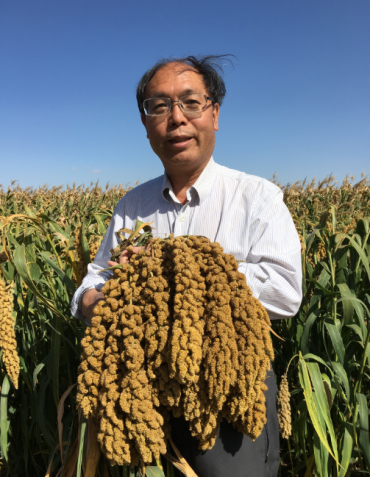
Zhao Zhihai, inventor "Zhangzagu" hybrid foxtail millet series variety (Photo courtesy of Zhangjiakou Academy of Agricultural Sciences)
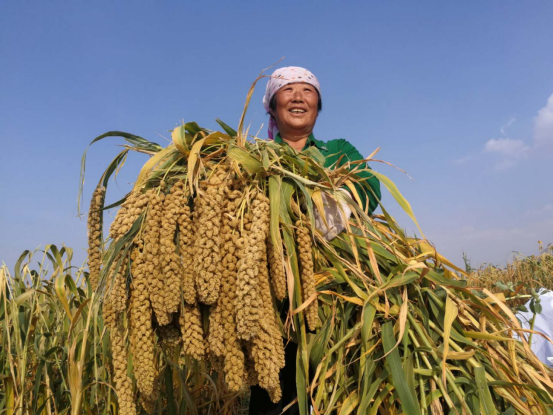
"Zhangzagu" hybrid foxtail millet can be an essential food crop with balanced and rich nutrition and can also serve as the main feed and forage for animal husbandry. The dual-use nature of millet for both grain and feed is unparalleled by other crops. (Photo courtesy of Zhangjiakou Academy of Agricultural Sciences)
From 2008 to 2011, the Zhangjiakou Academy of Agricultural Sciences conducted small-scale trials of hybrid millet in Ethiopia for four consecutive years, exploring suitable "Zhangzagu" hybrid foxtail millet varieties and cultivation techniques for Ethiopian farmers. In 2011, the average yield of the two trial sites (covering a total of 40 acres) reached 266 kg per acre, which was 2.27 times the local yield of moss.
By the end of 2014, the cultivation of hybrid millet had been gradually expanded to four regional states in Ethiopia.
Ⅱ. Approaches and Methodology

The model of hybrid millet value chain in Africa
Constructing the Hybrid Millet Value Chain: Focusing on upstream technology research and development and downstream product transformation, while entrusting the middle planting part to local farmers to drive local development (without establishing large-scale farms).
1) Extensive cooperation to build the millet value chain in Ethiopia
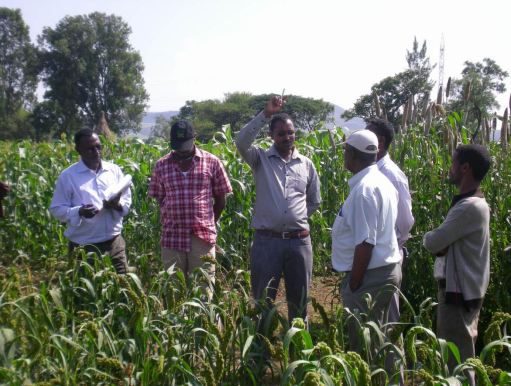
Experts from the Ethiopian Ministry of Agriculture's Variety Registration Committee evaluated the hybrid millet, and in 2011, the E7 and E10 hybrid millet varieties were registered in Ethiopia. (Photo courtesy of Zhangjiakou Academy of Agricultural Sciences)

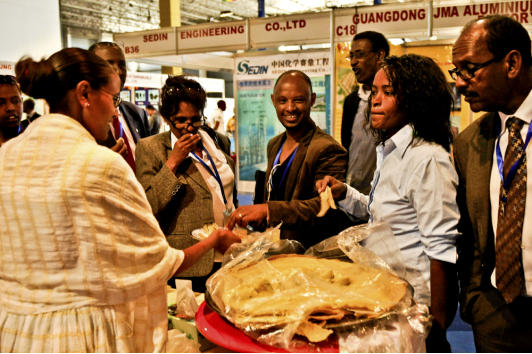
“Injera" made from hybrid millet was well-received by the local government and people at an exhibition in Ethiopia. (Photo courtesy of Zhangjiakou Academy of Agricultural Sciences)
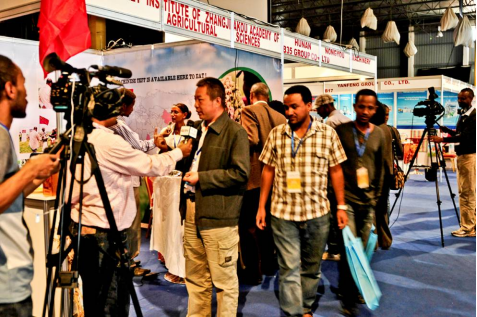
Liu Wenguang, a Chinese expert in South-South Cooperation stationed in Ethiopia, was interviewed by a local TV station to promote Chinese millet products. (Photo courtesy of Zhangjiakou Academy of Agricultural Sciences)
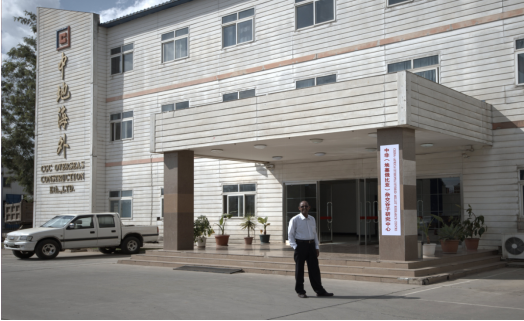
China-Africa (Ethiopia) Hybrid Millet Research Centre
(Photo courtesy of Zhangjiakou Academy of Agricultural Sciences)
2) Conducting hybrid millet experimental demonstrations with a focus on technical guidance
Considering Ethiopia's agricultural situation and based on the development of various individual cultivation techniques, the project conducted technology integration demonstrations tailored to local productivity conditions, focusing on the ecological characteristics of Ethiopia's main grain-producing areas and local farmers' planting habits. The demonstrations aimed to provide comprehensive technical solutions while emphasizing targeted and exemplary guidance.
Additionally, the Zhangjiakou Academy of Agricultural Sciences has dispatched 2-4 professional technical personnel to Ethiopia each year for on-site management, technical training and international exchange.
3) Introducing small-scale agricultural machinery to improve production efficiency
The Zhangjiakou Academy of Agricultural Sciences emphasizes the practicality of millet cultivation technology promotion in Africa, making it accessible to ordinary farmers. For example, in 2013, small hand-push seeders were introduced to Ethiopia, significantly improving the efficiency of smallholder manual operations.
4) Establishing a reasonable millet planting and consumption channel
The diversified hybrid millet value chain in Ethiopia includes: 1) millet food and by-products, mainly ensuring basic food supply, and 2) leading with animal husbandry, promoting the rapid development of millet forage, and transforming resource advantages into high economic value-added industries.
5) Promoting millet product processing and logistics to enhance the commercialization of agriculture and animal husbandry
The large post-harvest losses and low quality of agricultural products in Ethiopia are closely related to its processing capacity and technology. Improving the processing level of agricultural products is an essential means to enhance the benefits of Ethiopian agriculture.
Therefore, Ethiopia is implementing agricultural product processing and logistics, taking millet "Injera" production, millet flour processing, and millet forage processing and circulation as entry points. It adopts the industrialized operation model of "leading enterprises + bases + farmers," establishing large-scale, standardized planting bases, feed bases, and agricultural product logistics bases (distribution centers). At the same time, various professional associations and intermediary organizations are established, market construction is strengthened, and the social service system is improved. This comprehensive approach aims to enhance the standardization level of agricultural and animal husbandry production and the logistics and storage level, rapidly forming a pattern of efficient agricultural and animal husbandry industrialization. Processing promotes breeding, breeding drives planting, and a well-equipped logistics and storage system continuously adjusts and improves the economic structure of agriculture and animal husbandry, promoting farmers' income increase.
III. Project Outcomes and Output
2012 trial site: Hawasa Farm (south of Addis Ababa), where its soil type is sandy loam, planting area of 30 hectares, average yield per acre of 215.1 kg.
2012 trial site: Gibe Farm (west of Addis Ababa), where its soil type is volcanic ash-formed clay, planting area of 30 hectares, average yield per acre of 203.9 kg.
The successful planting of "Zhang Millet" in Ethiopia has aroused strong interest in other African countries. Uganda, Nigeria, and Namibia have conducted trials one after another, with yields significantly higher than local similar crops. The promotion and planting of Chinese hybrid millet in arid areas worldwide will help address the increasingly severe food crisis.
Ⅳ. Lessons learned
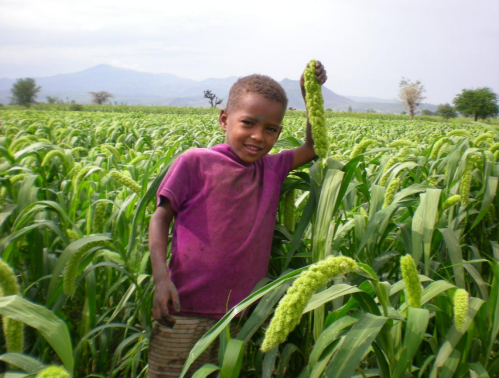
(Photo courtesy of Zhangjiakou Academy of Agricultural Sciences)
The successful promotion of "Zhangzagu" hybrid millet in Ethiopia has played a positive role in addressing food security issues, improving agricultural production efficiency, and increasing farmers' income. In the future, the project team will continue to strengthen cooperation with Ethiopian partners, explore new cooperation models, and further promote the development of the millet industry in Ethiopia. The project's experience and lessons can be shared with other countries facing similar challenges, contributing to the global goal of eradicating hunger and achieving food security.

For more information, please contact WFP China COE (wfpcn.coe@wfp.org)
Category
Addressing Food Crisis: Cultivating Millet Value Chain in Ethiopia
Contributor
Addressing Food Crisis: Cultivating Millet Value Chain in Ethiopia
Country
Case Study

